Solution of Linear Algebra Problems
VerifiedAdded on 2019/10/30
|5
|458
|418
Project
AI Summary
The assignment content discusses various mathematical problems and solutions related to linear algebra. It covers topics such as proof by induction, LU decomposition, row echelon form, subspace, eigenvalues, eigenvectors, orthogonal basis, and matrix operations.
Contribute Materials
Your contribution can guide someone’s learning journey. Share your
documents today.
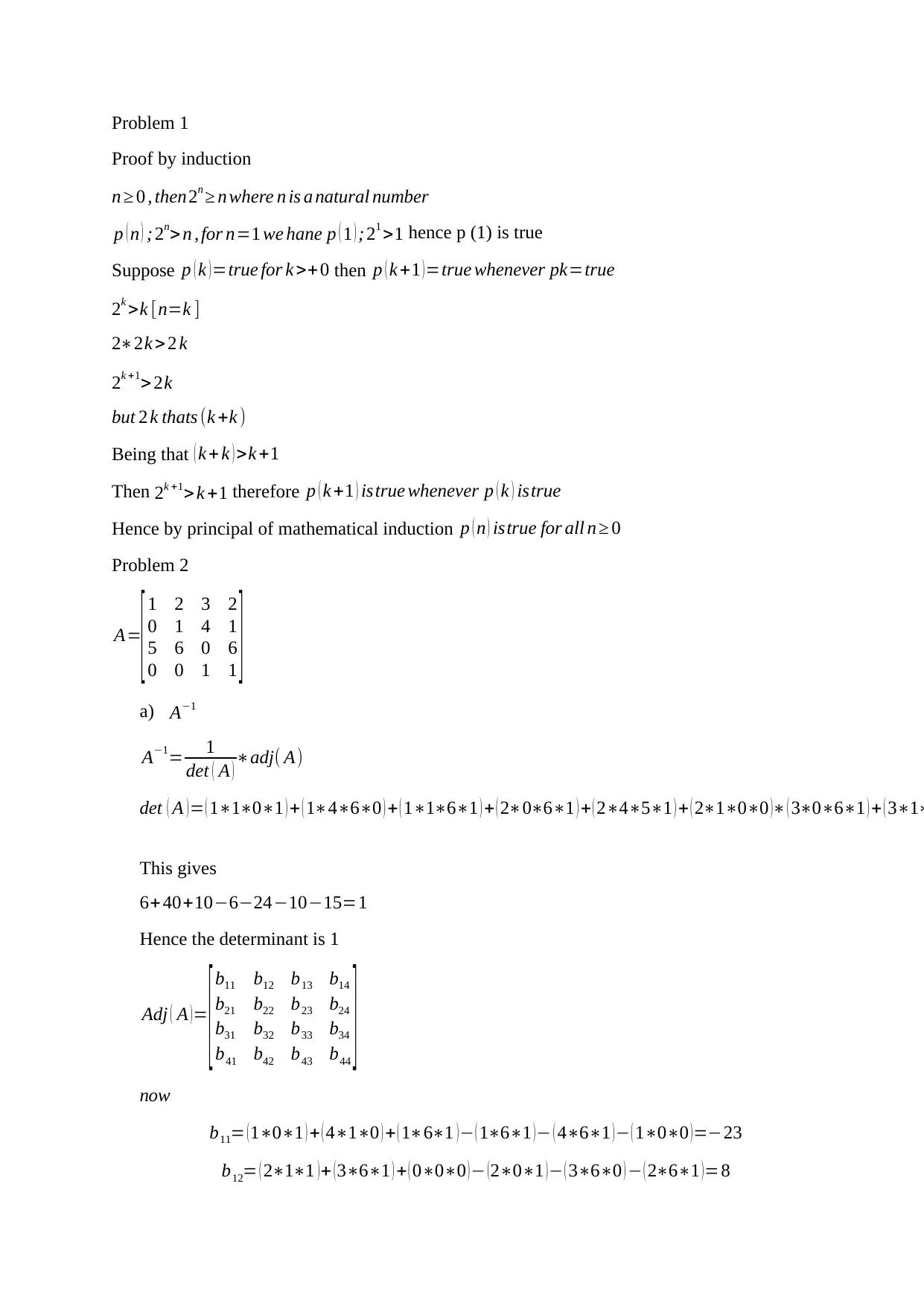
Problem 1
Proof by induction
n ≥ 0 , then2n ≥ n where n is a natural number
p ( n ) ; 2n> n , for n=1 we hane p ( 1 ) ;21 >1 hence p (1) is true
Suppose p ( k )=true for k >+0 then p ( k +1 )=true whenever pk=true
2k >k [n=k ]
2∗2k >2 k
2k +1> 2k
but 2 k thats (k +k )
Being that ( k + k ) >k +1
Then 2k +1> k +1 therefore p ( k +1 ) istrue whenever p ( k ) istrue
Hence by principal of mathematical induction p ( n ) istrue for all n ≥ 0
Problem 2
A=
[1 2 3 2
0 1 4 1
5 6 0 6
0 0 1 1 ]
a) A−1
A−1= 1
det ( A ) ∗adj( A)
det ( A ) = ( 1∗1∗0∗1 ) + ( 1∗4∗6∗0 ) + ( 1∗1∗6∗1 ) + ( 2∗0∗6∗1 ) + ( 2∗4∗5∗1 ) + ( 2∗1∗0∗0 )∗ ( 3∗0∗6∗1 ) + ( 3∗1∗
This gives
6+ 40+10−6−24−10−15=1
Hence the determinant is 1
Adj ( A )=
[b11 b12 b13 b14
b21 b22 b23 b24
b31 b32 b33 b34
b41 b42 b43 b44
]now
b11= ( 1∗0∗1 ) + ( 4∗1∗0 ) + ( 1∗6∗1 ) − ( 1∗6∗1 ) − ( 4∗6∗1 ) − ( 1∗0∗0 ) =−23
b12= ( 2∗1∗1 ) + ( 3∗6∗1 ) + ( 0∗0∗0 ) − ( 2∗0∗1 ) − ( 3∗6∗0 ) − ( 2∗6∗1 ) =8
Proof by induction
n ≥ 0 , then2n ≥ n where n is a natural number
p ( n ) ; 2n> n , for n=1 we hane p ( 1 ) ;21 >1 hence p (1) is true
Suppose p ( k )=true for k >+0 then p ( k +1 )=true whenever pk=true
2k >k [n=k ]
2∗2k >2 k
2k +1> 2k
but 2 k thats (k +k )
Being that ( k + k ) >k +1
Then 2k +1> k +1 therefore p ( k +1 ) istrue whenever p ( k ) istrue
Hence by principal of mathematical induction p ( n ) istrue for all n ≥ 0
Problem 2
A=
[1 2 3 2
0 1 4 1
5 6 0 6
0 0 1 1 ]
a) A−1
A−1= 1
det ( A ) ∗adj( A)
det ( A ) = ( 1∗1∗0∗1 ) + ( 1∗4∗6∗0 ) + ( 1∗1∗6∗1 ) + ( 2∗0∗6∗1 ) + ( 2∗4∗5∗1 ) + ( 2∗1∗0∗0 )∗ ( 3∗0∗6∗1 ) + ( 3∗1∗
This gives
6+ 40+10−6−24−10−15=1
Hence the determinant is 1
Adj ( A )=
[b11 b12 b13 b14
b21 b22 b23 b24
b31 b32 b33 b34
b41 b42 b43 b44
]now
b11= ( 1∗0∗1 ) + ( 4∗1∗0 ) + ( 1∗6∗1 ) − ( 1∗6∗1 ) − ( 4∗6∗1 ) − ( 1∗0∗0 ) =−23
b12= ( 2∗1∗1 ) + ( 3∗6∗1 ) + ( 0∗0∗0 ) − ( 2∗0∗1 ) − ( 3∗6∗0 ) − ( 2∗6∗1 ) =8
Secure Best Marks with AI Grader
Need help grading? Try our AI Grader for instant feedback on your assignments.
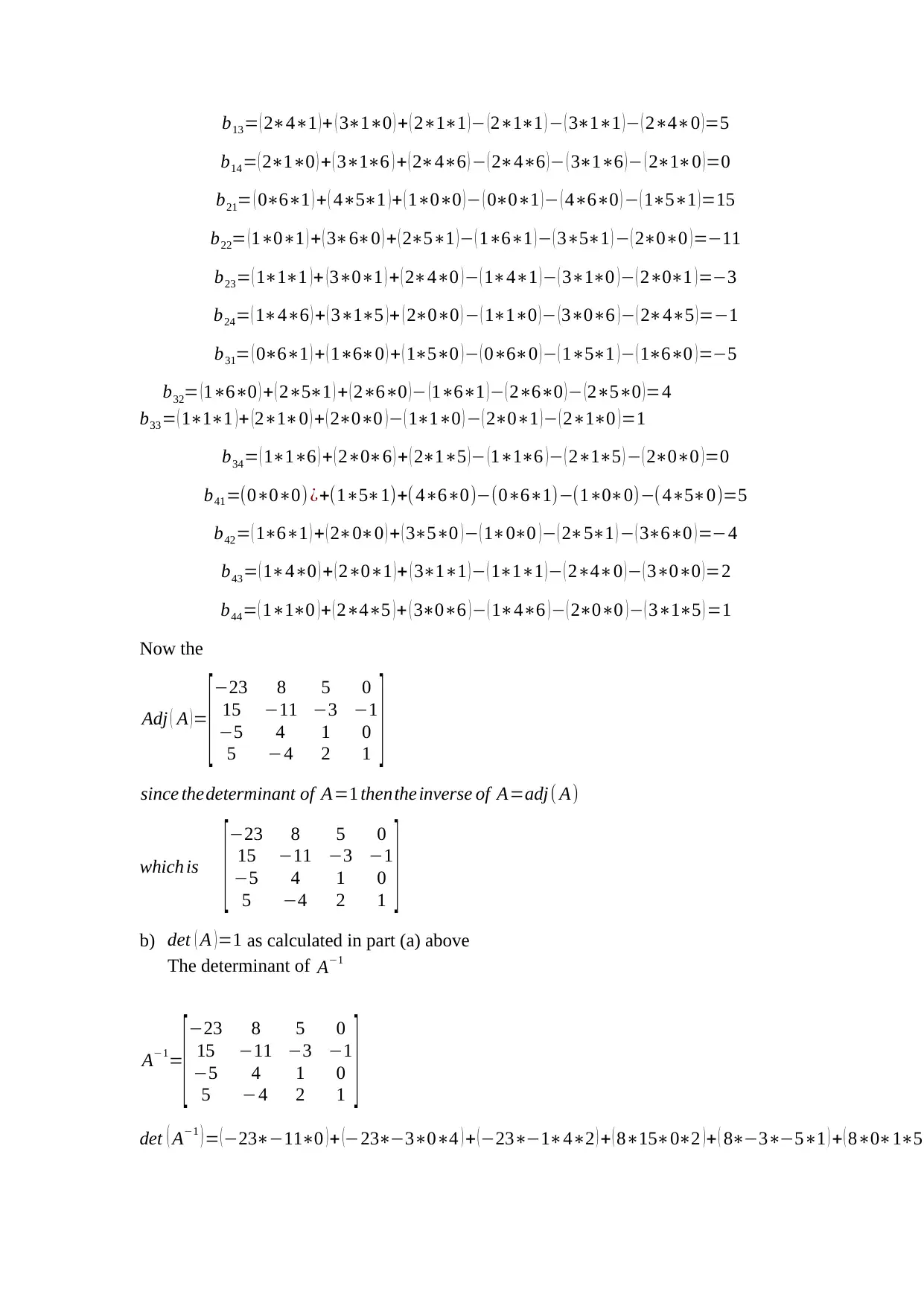
b13= ( 2∗4∗1 )+ ( 3∗1∗0 ) + ( 2∗1∗1 )− (2∗1∗1 ) − ( 3∗1∗1 )− ( 2∗4∗0 )=5
b14= ( 2∗1∗0 ) + ( 3∗1∗6 ) + ( 2∗4∗6 ) − ( 2∗4∗6 ) − ( 3∗1∗6 ) − ( 2∗1∗0 ) =0
b21= ( 0∗6∗1 ) + ( 4∗5∗1 )+ ( 1∗0∗0 )− ( 0∗0∗1 )− ( 4∗6∗0 ) − ( 1∗5∗1 )=15
b22= (1∗0∗1 ) + ( 3∗6∗0 ) + ( 2∗5∗1 )− ( 1∗6∗1 )− ( 3∗5∗1 ) − ( 2∗0∗0 )=−11
b23= ( 1∗1∗1 )+ (3∗0∗1 ) + ( 2∗4∗0 )− ( 1∗4∗1 )− ( 3∗1∗0 )− ( 2∗0∗1 )=−3
b24= ( 1∗4∗6 ) + ( 3∗1∗5 )+ ( 2∗0∗0 ) − ( 1∗1∗0 )− (3∗0∗6 )− ( 2∗4∗5 )=−1
b31= ( 0∗6∗1 ) + ( 1∗6∗0 ) + ( 1∗5∗0 ) − ( 0∗6∗0 ) − ( 1∗5∗1 ) − ( 1∗6∗0 ) =−5
b32= (1∗6∗0 ) + ( 2∗5∗1 ) + ( 2∗6∗0 )− (1∗6∗1 )− ( 2∗6∗0 )− (2∗5∗0 )=4
b33= ( 1∗1∗1 )+ (2∗1∗0 ) + ( 2∗0∗0 )− ( 1∗1∗0 ) − ( 2∗0∗1 )− ( 2∗1∗0 )=1
b34= ( 1∗1∗6 ) + ( 2∗0∗6 ) + ( 2∗1∗5 )− (1∗1∗6 )− ( 2∗1∗5 ) − ( 2∗0∗0 )=0
b41=(0∗0∗0) ¿+(1∗5∗1)+( 4∗6∗0)−(0∗6∗1)−(1∗0∗0)−( 4∗5∗0)=5
b42= ( 1∗6∗1 ) + ( 2∗0∗0 ) + ( 3∗5∗0 )− ( 1∗0∗0 )− ( 2∗5∗1 ) − ( 3∗6∗0 )=−4
b43= ( 1∗4∗0 ) + ( 2∗0∗1 ) + ( 3∗1∗1 ) − ( 1∗1∗1 ) − ( 2∗4∗0 ) − ( 3∗0∗0 ) =2
b44= ( 1∗1∗0 )+ ( 2∗4∗5 )+ ( 3∗0∗6 )− ( 1∗4∗6 )− ( 2∗0∗0 )− ( 3∗1∗5 ) =1
Now the
Adj ( A )=
[−23 8 5 0
15 −11 −3 −1
−5 4 1 0
5 −4 2 1 ]
since thedeterminant of A=1 thentheinverse of A=adj( A)
which is
[−23 8 5 0
15 −11 −3 −1
−5 4 1 0
5 −4 2 1 ]
b) det ( A ) =1 as calculated in part (a) above
The determinant of A−1
A−1=
[ −23 8 5 0
15 −11 −3 −1
−5 4 1 0
5 −4 2 1 ]
det ( A−1 ) = (−23∗−11∗0 )+ (−23∗−3∗0∗4 ) + (−23∗−1∗4∗2 ) + ( 8∗15∗0∗2 )+ ( 8∗−3∗−5∗1 ) + ( 8∗0∗1∗5
b14= ( 2∗1∗0 ) + ( 3∗1∗6 ) + ( 2∗4∗6 ) − ( 2∗4∗6 ) − ( 3∗1∗6 ) − ( 2∗1∗0 ) =0
b21= ( 0∗6∗1 ) + ( 4∗5∗1 )+ ( 1∗0∗0 )− ( 0∗0∗1 )− ( 4∗6∗0 ) − ( 1∗5∗1 )=15
b22= (1∗0∗1 ) + ( 3∗6∗0 ) + ( 2∗5∗1 )− ( 1∗6∗1 )− ( 3∗5∗1 ) − ( 2∗0∗0 )=−11
b23= ( 1∗1∗1 )+ (3∗0∗1 ) + ( 2∗4∗0 )− ( 1∗4∗1 )− ( 3∗1∗0 )− ( 2∗0∗1 )=−3
b24= ( 1∗4∗6 ) + ( 3∗1∗5 )+ ( 2∗0∗0 ) − ( 1∗1∗0 )− (3∗0∗6 )− ( 2∗4∗5 )=−1
b31= ( 0∗6∗1 ) + ( 1∗6∗0 ) + ( 1∗5∗0 ) − ( 0∗6∗0 ) − ( 1∗5∗1 ) − ( 1∗6∗0 ) =−5
b32= (1∗6∗0 ) + ( 2∗5∗1 ) + ( 2∗6∗0 )− (1∗6∗1 )− ( 2∗6∗0 )− (2∗5∗0 )=4
b33= ( 1∗1∗1 )+ (2∗1∗0 ) + ( 2∗0∗0 )− ( 1∗1∗0 ) − ( 2∗0∗1 )− ( 2∗1∗0 )=1
b34= ( 1∗1∗6 ) + ( 2∗0∗6 ) + ( 2∗1∗5 )− (1∗1∗6 )− ( 2∗1∗5 ) − ( 2∗0∗0 )=0
b41=(0∗0∗0) ¿+(1∗5∗1)+( 4∗6∗0)−(0∗6∗1)−(1∗0∗0)−( 4∗5∗0)=5
b42= ( 1∗6∗1 ) + ( 2∗0∗0 ) + ( 3∗5∗0 )− ( 1∗0∗0 )− ( 2∗5∗1 ) − ( 3∗6∗0 )=−4
b43= ( 1∗4∗0 ) + ( 2∗0∗1 ) + ( 3∗1∗1 ) − ( 1∗1∗1 ) − ( 2∗4∗0 ) − ( 3∗0∗0 ) =2
b44= ( 1∗1∗0 )+ ( 2∗4∗5 )+ ( 3∗0∗6 )− ( 1∗4∗6 )− ( 2∗0∗0 )− ( 3∗1∗5 ) =1
Now the
Adj ( A )=
[−23 8 5 0
15 −11 −3 −1
−5 4 1 0
5 −4 2 1 ]
since thedeterminant of A=1 thentheinverse of A=adj( A)
which is
[−23 8 5 0
15 −11 −3 −1
−5 4 1 0
5 −4 2 1 ]
b) det ( A ) =1 as calculated in part (a) above
The determinant of A−1
A−1=
[ −23 8 5 0
15 −11 −3 −1
−5 4 1 0
5 −4 2 1 ]
det ( A−1 ) = (−23∗−11∗0 )+ (−23∗−3∗0∗4 ) + (−23∗−1∗4∗2 ) + ( 8∗15∗0∗2 )+ ( 8∗−3∗−5∗1 ) + ( 8∗0∗1∗5
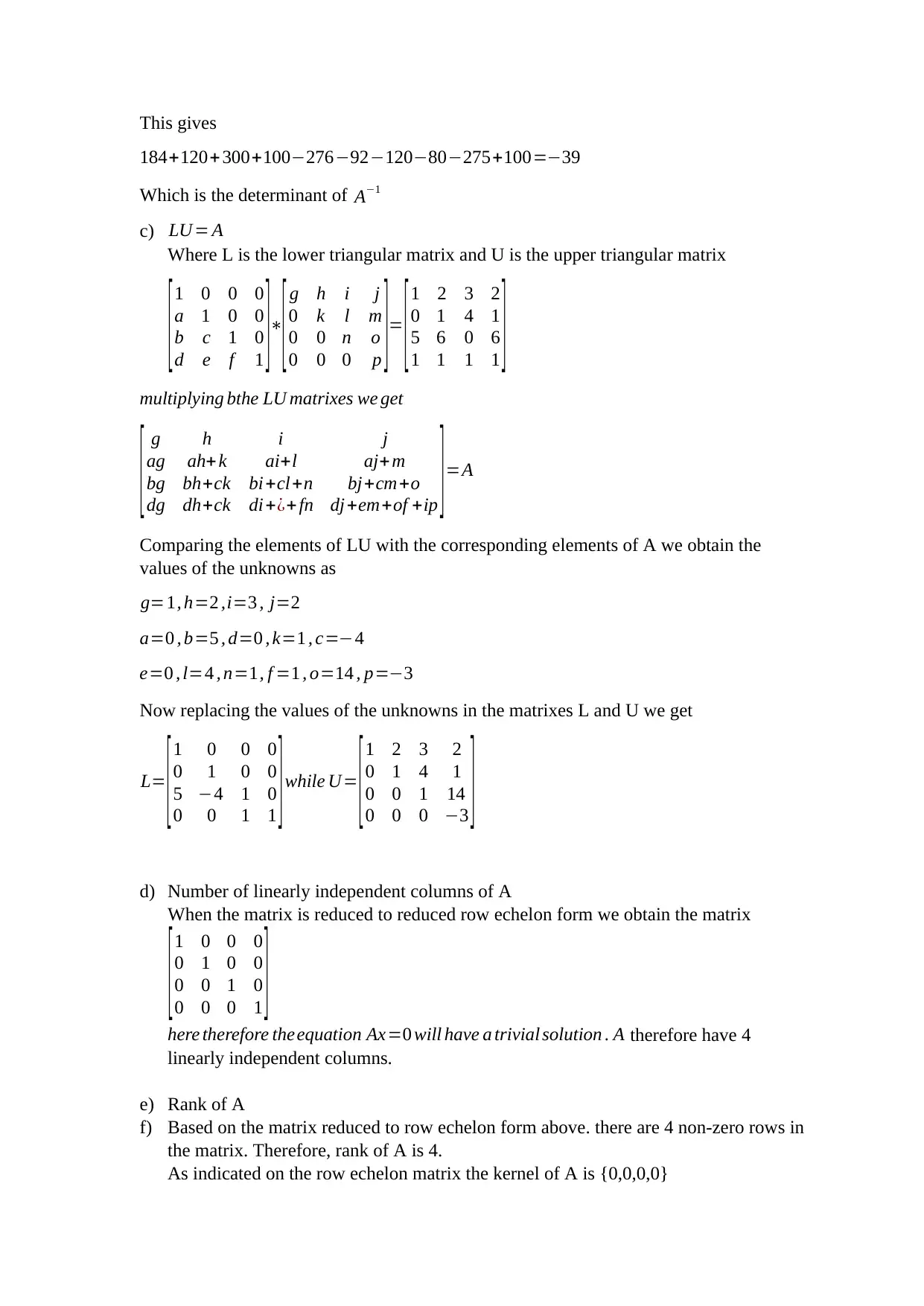
This gives
184+120+ 300+100−276−92−120−80−275+100=−39
Which is the determinant of A−1
c) LU = A
Where L is the lower triangular matrix and U is the upper triangular matrix
[1 0 0 0
a 1 0 0
b c 1 0
d e f 1 ]∗
[ g h i j
0 k l m
0 0 n o
0 0 0 p ]=
[1 2 3 2
0 1 4 1
5 6 0 6
1 1 1 1 ]
multiplying bthe LU matrixes we get
[ g h i j
ag ah+ k ai+l aj+ m
bg bh+ck bi+cl+n bj+cm+o
dg dh+ck di+¿+ fn dj+em+of +ip ]=A
Comparing the elements of LU with the corresponding elements of A we obtain the
values of the unknowns as
g=1, h=2 ,i=3 , j=2
a=0 , b=5 , d=0 , k=1 , c=−4
e=0 , l=4 , n=1, f =1 , o=14 , p=−3
Now replacing the values of the unknowns in the matrixes L and U we get
L=
[1 0 0 0
0 1 0 0
5 −4 1 0
0 0 1 1 ]while U=
[1 2 3 2
0 1 4 1
0 0 1 14
0 0 0 −3 ]
d) Number of linearly independent columns of A
When the matrix is reduced to reduced row echelon form we obtain the matrix
[1 0 0 0
0 1 0 0
0 0 1 0
0 0 0 1 ]here therefore theequation Ax=0 will have a trivial solution . A therefore have 4
linearly independent columns.
e) Rank of A
f) Based on the matrix reduced to row echelon form above. there are 4 non-zero rows in
the matrix. Therefore, rank of A is 4.
As indicated on the row echelon matrix the kernel of A is {0,0,0,0}
184+120+ 300+100−276−92−120−80−275+100=−39
Which is the determinant of A−1
c) LU = A
Where L is the lower triangular matrix and U is the upper triangular matrix
[1 0 0 0
a 1 0 0
b c 1 0
d e f 1 ]∗
[ g h i j
0 k l m
0 0 n o
0 0 0 p ]=
[1 2 3 2
0 1 4 1
5 6 0 6
1 1 1 1 ]
multiplying bthe LU matrixes we get
[ g h i j
ag ah+ k ai+l aj+ m
bg bh+ck bi+cl+n bj+cm+o
dg dh+ck di+¿+ fn dj+em+of +ip ]=A
Comparing the elements of LU with the corresponding elements of A we obtain the
values of the unknowns as
g=1, h=2 ,i=3 , j=2
a=0 , b=5 , d=0 , k=1 , c=−4
e=0 , l=4 , n=1, f =1 , o=14 , p=−3
Now replacing the values of the unknowns in the matrixes L and U we get
L=
[1 0 0 0
0 1 0 0
5 −4 1 0
0 0 1 1 ]while U=
[1 2 3 2
0 1 4 1
0 0 1 14
0 0 0 −3 ]
d) Number of linearly independent columns of A
When the matrix is reduced to reduced row echelon form we obtain the matrix
[1 0 0 0
0 1 0 0
0 0 1 0
0 0 0 1 ]here therefore theequation Ax=0 will have a trivial solution . A therefore have 4
linearly independent columns.
e) Rank of A
f) Based on the matrix reduced to row echelon form above. there are 4 non-zero rows in
the matrix. Therefore, rank of A is 4.
As indicated on the row echelon matrix the kernel of A is {0,0,0,0}
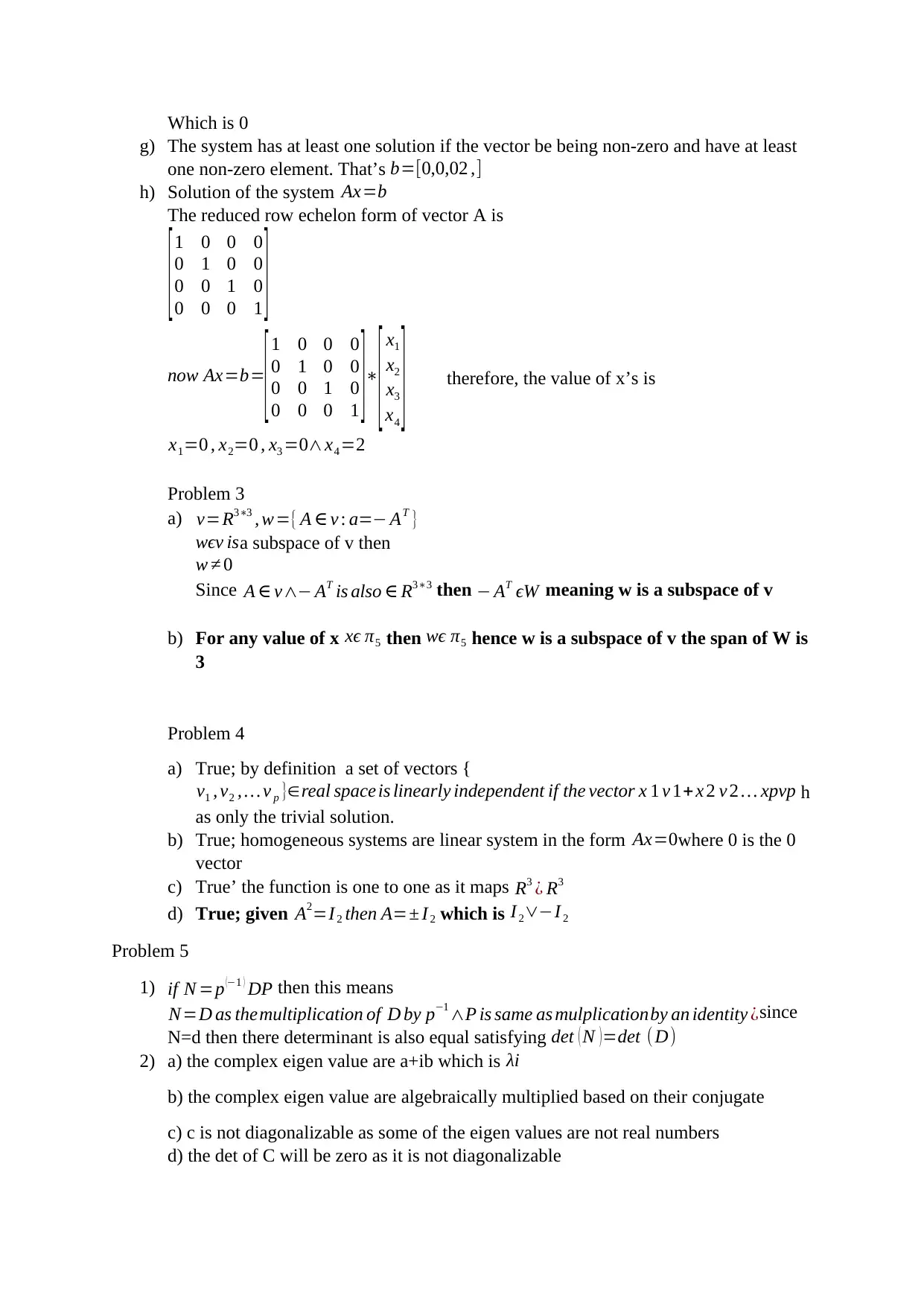
Which is 0
g) The system has at least one solution if the vector be being non-zero and have at least
one non-zero element. That’s b=[0,0,02 ,]
h) Solution of the system Ax=b
The reduced row echelon form of vector A is
[1 0 0 0
0 1 0 0
0 0 1 0
0 0 0 1 ]
now Ax=b=
[1 0 0 0
0 1 0 0
0 0 1 0
0 0 0 1 ]∗
[ x1
x2
x3
x4
] therefore, the value of x’s is
x1=0 , x2=0 , x3 =0∧x4 =2
Problem 3
a) v=R3∗3 , w={ A ∈ v : a=− AT }
wϵv isa subspace of v then
w ≠ 0
Since A ∈ v∧− AT is also ∈ R3∗3 then − AT ϵW meaning w is a subspace of v
b) For any value of x xϵ π5 then wϵ π5 hence w is a subspace of v the span of W is
3
Problem 4
a) True; by definition a set of vectors {
v1 , v2 , … v p }∈real space is linearly independent if the vector x 1 v 1+ x 2 v 2 … xpvp h
as only the trivial solution.
b) True; homogeneous systems are linear system in the form Ax=0where 0 is the 0
vector
c) True’ the function is one to one as it maps R3 ¿ R3
d) True; given A2=I 2 then A=± I2 which is I 2∨−I 2
Problem 5
1) if N =p (−1 ) DP then this means
N=D as themultiplication of D by p−1 ∧P is same as mulplicationby an identity ¿since
N=d then there determinant is also equal satisfying det ( N )=det ( D)
2) a) the complex eigen value are a+ib which is λi
b) the complex eigen value are algebraically multiplied based on their conjugate
c) c is not diagonalizable as some of the eigen values are not real numbers
d) the det of C will be zero as it is not diagonalizable
g) The system has at least one solution if the vector be being non-zero and have at least
one non-zero element. That’s b=[0,0,02 ,]
h) Solution of the system Ax=b
The reduced row echelon form of vector A is
[1 0 0 0
0 1 0 0
0 0 1 0
0 0 0 1 ]
now Ax=b=
[1 0 0 0
0 1 0 0
0 0 1 0
0 0 0 1 ]∗
[ x1
x2
x3
x4
] therefore, the value of x’s is
x1=0 , x2=0 , x3 =0∧x4 =2
Problem 3
a) v=R3∗3 , w={ A ∈ v : a=− AT }
wϵv isa subspace of v then
w ≠ 0
Since A ∈ v∧− AT is also ∈ R3∗3 then − AT ϵW meaning w is a subspace of v
b) For any value of x xϵ π5 then wϵ π5 hence w is a subspace of v the span of W is
3
Problem 4
a) True; by definition a set of vectors {
v1 , v2 , … v p }∈real space is linearly independent if the vector x 1 v 1+ x 2 v 2 … xpvp h
as only the trivial solution.
b) True; homogeneous systems are linear system in the form Ax=0where 0 is the 0
vector
c) True’ the function is one to one as it maps R3 ¿ R3
d) True; given A2=I 2 then A=± I2 which is I 2∨−I 2
Problem 5
1) if N =p (−1 ) DP then this means
N=D as themultiplication of D by p−1 ∧P is same as mulplicationby an identity ¿since
N=d then there determinant is also equal satisfying det ( N )=det ( D)
2) a) the complex eigen value are a+ib which is λi
b) the complex eigen value are algebraically multiplied based on their conjugate
c) c is not diagonalizable as some of the eigen values are not real numbers
d) the det of C will be zero as it is not diagonalizable
Secure Best Marks with AI Grader
Need help grading? Try our AI Grader for instant feedback on your assignments.
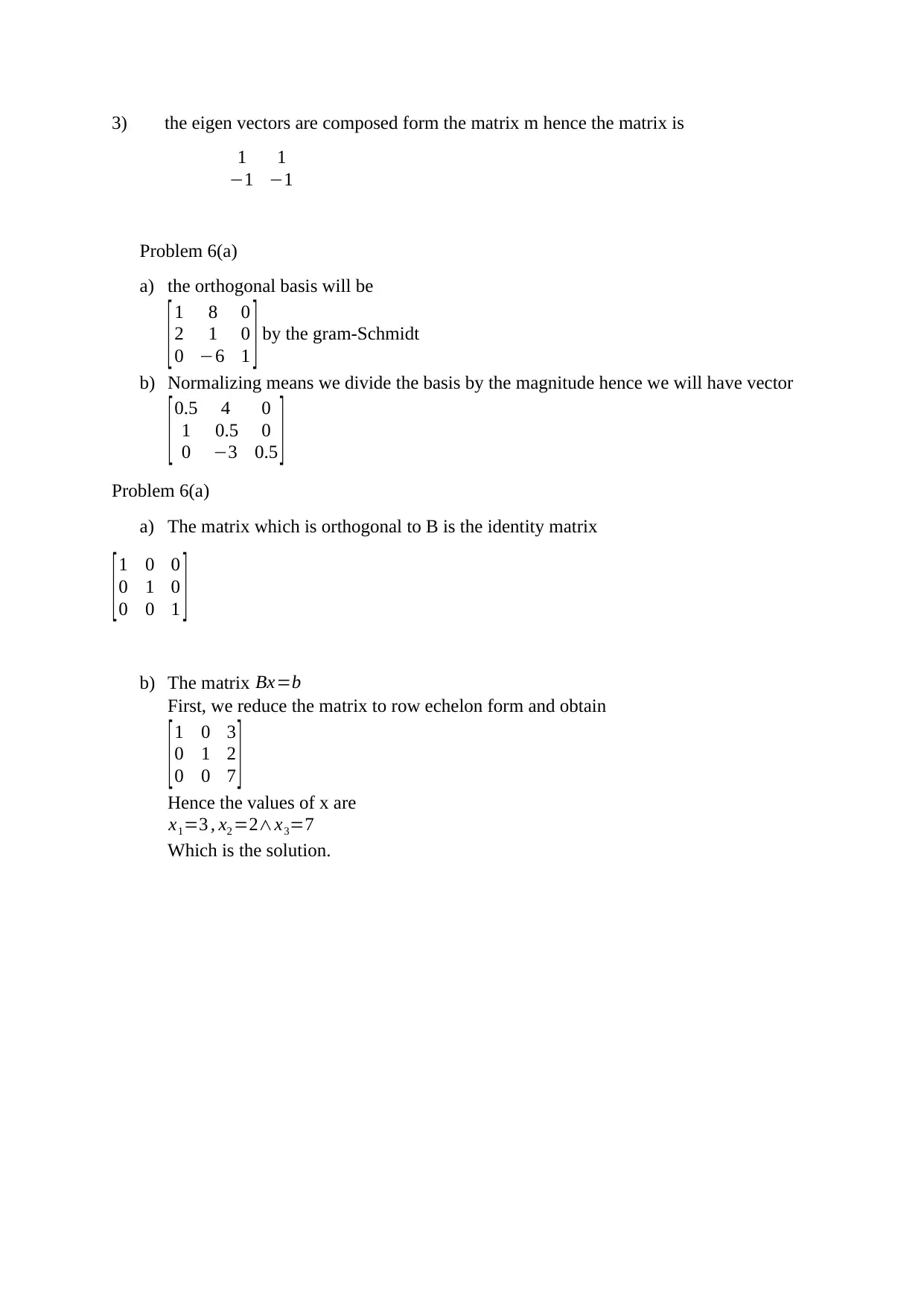
3) the eigen vectors are composed form the matrix m hence the matrix is
1 1
−1 −1
Problem 6(a)
a) the orthogonal basis will be
[ 1 8 0
2 1 0
0 −6 1 ] by the gram-Schmidt
b) Normalizing means we divide the basis by the magnitude hence we will have vector
[0.5 4 0
1 0.5 0
0 −3 0.5 ]
Problem 6(a)
a) The matrix which is orthogonal to B is the identity matrix
[1 0 0
0 1 0
0 0 1 ]
b) The matrix Bx=b
First, we reduce the matrix to row echelon form and obtain
[1 0 3
0 1 2
0 0 7 ]Hence the values of x are
x1=3 , x2 =2∧x3=7
Which is the solution.
1 1
−1 −1
Problem 6(a)
a) the orthogonal basis will be
[ 1 8 0
2 1 0
0 −6 1 ] by the gram-Schmidt
b) Normalizing means we divide the basis by the magnitude hence we will have vector
[0.5 4 0
1 0.5 0
0 −3 0.5 ]
Problem 6(a)
a) The matrix which is orthogonal to B is the identity matrix
[1 0 0
0 1 0
0 0 1 ]
b) The matrix Bx=b
First, we reduce the matrix to row echelon form and obtain
[1 0 3
0 1 2
0 0 7 ]Hence the values of x are
x1=3 , x2 =2∧x3=7
Which is the solution.
1 out of 5
Related Documents
Your All-in-One AI-Powered Toolkit for Academic Success.
+13062052269
info@desklib.com
Available 24*7 on WhatsApp / Email
![[object Object]](/_next/static/media/star-bottom.7253800d.svg)
Unlock your academic potential
© 2024 | Zucol Services PVT LTD | All rights reserved.





